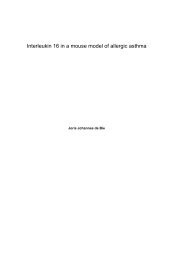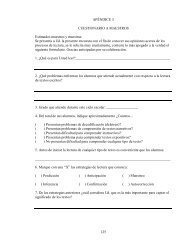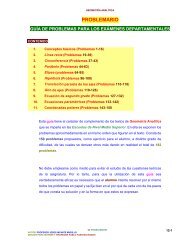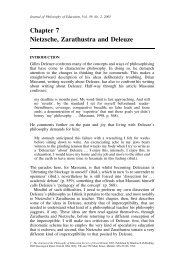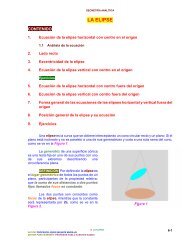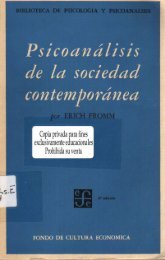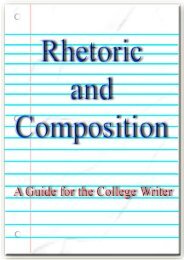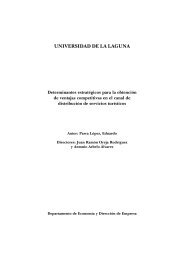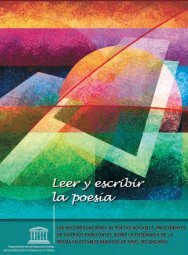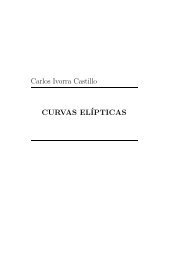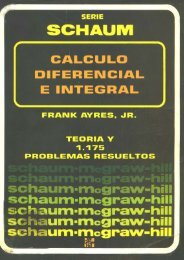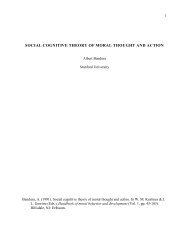- Page 1 and 2:
Curso Curso 1994/95 1994/95 HUMANID
- Page 3 and 4:
También quiero agradecer a los com
- Page 5 and 6:
INDICE GENERAL CAPÍTULO 0: INTRODU
- Page 7 and 8:
CAPÍTULO 4: UNA CONTRASTACIÓN EMP
- Page 9 and 10:
predicción y recoger todos los pos
- Page 11 and 12:
Tiempo continuo Varianza Constante
- Page 13 and 14:
(medidos éstos en términos de ren
- Page 15 and 16:
S 1.1.- PROCESO DE DIFUSIÓN CON SA
- Page 17 and 18:
pequeñas variaciones aleatorias en
- Page 19 and 20:
susceptibles de un más asequible t
- Page 21 and 22:
1.- El supuesto de Movimiento Aritm
- Page 23 and 24:
donde PW es el precio de un warrant
- Page 25 and 26:
Finalmente, se llega al Proceso de
- Page 27 and 28:
Como expresan B-S, el concepto de c
- Page 29 and 30:
donde S es el precio de las accione
- Page 31 and 32:
d d 1 2 1 ln( S/ X) + ( r + 2 σ =
- Page 33 and 34:
Ross [1985] 10 ) (en adelante CIR),
- Page 35 and 36:
c P c(x o ,t) x o A 29 B C D x +dx
- Page 37 and 38:
subyacente en una fecha futura, opc
- Page 39 and 40:
alternativos al respecto, que van d
- Page 41 and 42:
Para solventar el problema de la va
- Page 43 and 44:
Finalmente, Amin y Jarrow (1992) pr
- Page 45 and 46:
que se incrementa cuando el precio
- Page 47 and 48:
efiriéndose a él como "modelo Rub
- Page 49 and 50:
⎧C C⎨ ⎩C u d = max = max [ 0,
- Page 51 and 52:
2º El valor de la opción no depen
- Page 53 and 54:
débilmente a un proceso de difusi
- Page 55 and 56:
- Para la valoración de deuda subo
- Page 57 and 58:
Un primera aplicación está en la
- Page 59 and 60:
S* t S α t + D-X GRÁFICO 2 53 S t
- Page 61 and 62:
dividendos. Se parte del caso más
- Page 63 and 64:
establecer de antemano unas fechas
- Page 65 and 66:
En este caso, aunque se utiliza la
- Page 67 and 68:
europea, pero menos valor que una p
- Page 69 and 70:
(δ ≡D / S). Además establece un
- Page 71 and 72:
2.-más una opción call europea so
- Page 73 and 74:
análisis, introduce el concepto de
- Page 75 and 76:
(ajuste de tendencias o incremento
- Page 77 and 78:
Del modelo se pueden obtener los ra
- Page 79 and 80:
La varianza de la tasa de rentabili
- Page 81 and 82:
Aunque la contrastación de los dat
- Page 83 and 84:
entabilidad del activo subyacente c
- Page 85 and 86:
calculan los valores de las opcione
- Page 87 and 88:
empresa se supone igual a una funci
- Page 89 and 90:
4º.-El modelo de difusión desplaz
- Page 91 and 92:
Esta dinámica también recoge el c
- Page 93 and 94:
último supuesto es equivalente a s
- Page 95 and 96:
91 φ(.) σ [ ρ ρ − ρ ] M Ms s
- Page 97 and 98:
obtienen como solución al valor de
- Page 99 and 100:
- hs,t y hc,t son la varianza del p
- Page 101 and 102:
Para la contrastación de esta fór
- Page 103 and 104:
los trabajos de Amin y NG (1993) y
- Page 105 and 106:
2 La expresión analítica del mode
- Page 107 and 108:
parámetros y permite efectos asim
- Page 109 and 110:
(generalmente un proceso autorregre
- Page 111 and 112:
Glosten-Jagannathan-Runkle (GJR) (1
- Page 113 and 114:
2.2.1. Volatilidad histórica o mue
- Page 115 and 116: Garman y Klass (1980) mejoran el es
- Page 117 and 118: Si hay "n" opciones sobre una acci
- Page 119 and 120: Plantea por tanto, el estudio de la
- Page 121 and 122: 2º Se evita el problema de la esti
- Page 123 and 124: de los activos al final del año. U
- Page 125 and 126: activos financieros, como ya detall
- Page 127 and 128: CAPÍTULO 3: PROCESO DE DIFUSIÓN C
- Page 129 and 130: infinita, Pareto-estables en Mandel
- Page 131 and 132: -Un término de "salto", de natural
- Page 133 and 134: donde dq y dZ se suponen procesos i
- Page 135 and 136: salta, experimentará comparativame
- Page 137 and 138: dP P ∗ ∗ ∗ ∗ = ( α − λ
- Page 139 and 140: 2º Cuando la variable aleatoria Y,
- Page 141 and 142: Finalmente y haciendo uso de la fó
- Page 143 and 144: cuando el salto ocurre y toma valor
- Page 145 and 146: El espacio de estados para la diná
- Page 147 and 148: La expresión [22] se simplifica ba
- Page 149 and 150: 3.3. PROCESOS DE DIFUSIÓN CON SALT
- Page 151 and 152: salto que ocurra en el precio de la
- Page 153 and 154: Para entender el efecto de los salt
- Page 155 and 156: Además, se han propuesto diferente
- Page 157 and 158: λ = σ δ 2 2 25( K = K = K α = K
- Page 159 and 160: Se puede observar que esta función
- Page 161 and 162: Las condiciones de primer orden de
- Page 163 and 164: A lo largo de los capítulos anteri
- Page 165: 64% GRÁFICO 1 OPCIONES SOBRE ACCIO
- Page 169 and 170: Como se desprende del análisis de
- Page 171 and 172: Como se puede observar de la Tabla
- Page 173 and 174: Continuo de las Bolsas Españolas 3
- Page 175 and 176: intervalos para los precios de ejer
- Page 177 and 178: C = x ≡ SN( x) − Kr -t log(S/Kr
- Page 179 and 180: TABLA 4 Valor de la volatilidad his
- Page 181 and 182: Por si aún fuera poco, se precisa
- Page 183 and 184: El procedimiento "naive" consiste e
- Page 185 and 186: 0,05 0,04 0,03 0,02 0,01 0 -0,01 -0
- Page 187 and 188: Además, procedimos a realizar un a
- Page 189 and 190: Los resultados obtenidos con el mé
- Page 191 and 192: Esta observación también se detec
- Page 193 and 194: curtosis (Tabla 7). Aún más, obtu
- Page 195 and 196: 18 16 14 12 10 8 6 4 2 0 -0,03125 1
- Page 197 and 198: 14 12 10 8 6 4 2 0 -0,03125 100,00%
- Page 199 and 200: 2 1,8 1,6 1,4 1,2 1 0,8 0,6 0,4 0,2
- Page 201 and 202: igual que en en el modelo de B-S, y
- Page 203 and 204: sobrevaloración se reduce y práct
- Page 205 and 206: 0,6 0,5 0,4 0,3 0,2 0,1 0 -0,1 0,4
- Page 207 and 208: - Sesgo de precio de ejercicio: Has
- Page 209 and 210: 0,4 0,3 0,2 0,1 0 -0,1 -0,2 1,016 1
- Page 211 and 212: 250 200 150 100 50 0 GRÁFICO 14 Va
- Page 213 and 214: 5 4,5 4 3,5 3 2,5 2 1,5 1 0,5 0 -0,
- Page 215 and 216: De igual manera, procedemos a anali
- Page 217 and 218:
precios de compra para la contrasta
- Page 219 and 220:
450 400 350 300 250 200 150 100 50
- Page 221 and 222:
0,7 0,6 0,5 0,4 0,3 0,2 0,1 0 -0,1
- Page 223 and 224:
están muy próximos a cero. Los va
- Page 225 and 226:
0,35 0,3 0,25 0,2 0,15 0,1 0,05 0 G
- Page 227 and 228:
TABLA 12 Vto. Diciembre, Precio de
- Page 229 and 230:
de compra, ya que para este precio
- Page 231 and 232:
0,6 0,5 0,4 0,3 0,2 0,1 0 GRÁFICO
- Page 233 and 234:
Se observa claramente el sesgo de p
- Page 235 and 236:
La tabla 15 muestra los estadístic
- Page 237 and 238:
3 2,5 2 1,5 1 0,5 0 2,5 2 1,5 1 0,5
- Page 239 and 240:
TABLA 16 VENCIMIENTO EN MARZO DE 19
- Page 241 and 242:
4.4. OTROS RESULTADOS OBTENIDOS UTI
- Page 243 and 244:
operadores) se obtuvo como resultad
- Page 245 and 246:
CAPÍTULO 5: CONCLUSIONES.
- Page 247 and 248:
variaciones reducidas en la rentabi
- Page 249 and 250:
los trabajos empíricos que analiza
- Page 251 and 252:
que son importantes en la descripci
- Page 253 and 254:
presencia de sesgos de precio de ej
- Page 255 and 256:
encaminadas, por un lado, a una may
- Page 257 and 258:
ANALISTAS FINANCIEROS INTERNACIONAL
- Page 259 and 260:
BLACK, F. (1975): "Fact and Fantasy
- Page 261 and 262:
Synthesis", Journal of Financial an
- Page 263 and 264:
COX, J. C., J. E. INGERSOLL y S. A.
- Page 265 and 266:
ENGLE, R. (1982): "Autoregressive C
- Page 267 and 268:
GESKE, R. (1975): "The Pricing of O
- Page 269 and 270:
HILLIARD, J. E., J. MADURA y A. L.
- Page 271 and 272:
KAROLYI, G. A. (1993): "A Bayesian
- Page 273 and 274:
LO, A. W. y A. C. MACKINLAY (1988):
- Page 275 and 276:
MERTON, R. C. y P. A. SAMUELSON (19
- Page 277 and 278:
POON, S. y T. HO (1992): "The GARCH
- Page 279 and 280:
RUIZ, E. (1993): "Stochastic Volati
- Page 281:
STULZ, R. M. (1982): "Options on th



